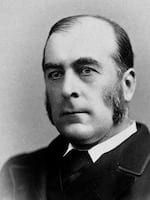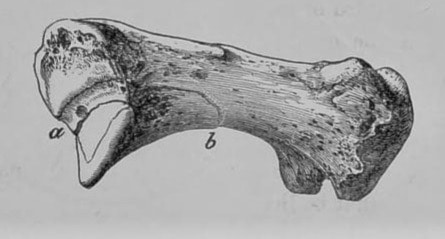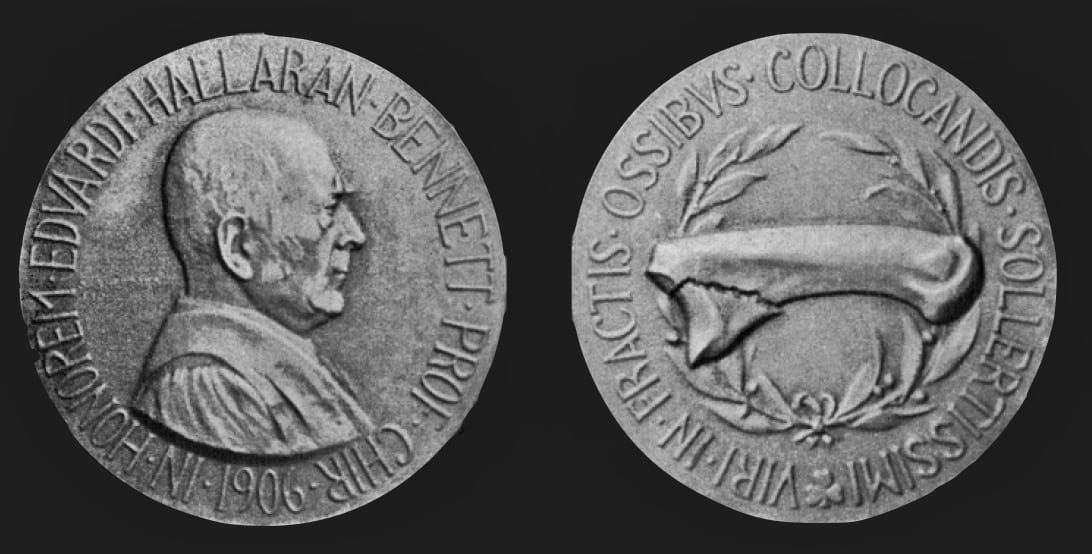Edward H Bennett
Edward Hallaran Bennett (1837-1907) was an Irish Surgeon.
Bennett created and curated a substantial collection of fractures, dislocations, diseases, and bones, which he arranged and catalogued, together with their clinical histories, in the Pathological Museum of Trinity College.
Described as a “model of honour and uprightness, blunt (sometimes emphatically so) and intolerant only of pretence. He was known popularly as ‘the Boss’.“
Early adopter surgeons of Lister’s antiseptic technique which he introduced into Dublin. Eponymously affiliated with the Bennett fracture first described in 1882
Biography
- Born on April 9, 1837 in Charlotte Quay, Cork
- 1854-1859 Medical school Trinity School, Dublin (AB, MB) and first graduate to receive the new degree of MCh
- 1863 – Fellow of the Royal College of Surgeons of Ireland (FRCSI)
- 1864 – Surgeon to Sir Patrick Dun’s Hospital and University Anatomist
- 1873 – Succeeded Robert William Smith as Professor of Surgery and Curator of the Pathological Museum, Trinity College
- 1880 – President of the Dublin Pathological Society
- 1884 – President of the Royal College of Surgeons of Ireland
- 1894-1897 President of the Royal Academy of Medicine in Ireland
- 1902-1905 Surgeon to the Lord Lieutenant, the Earl of Dudley
- Died on June 21, 1907 in Dublin
Medical Eponyms
Bennett fracture (1882)
Intra-articular two-part fracture of the base of the first metacarpal with carpometacarpal joint involvement. Thumb fracture usually sustained with forced abduction of the first metacarpal.
1881 – Bennett presented to a meeting of the Pathological Society of Dublin Nov 12th 1881 the fracture-dislocation now eponymous with him. He published his treatise on fractures of the base of the first metacarpal in the Dublin Journal of Medical Science. Bennet observed 27 first metacarpal fractures in a series of 113 metacarpal fractures.
…of the five examples of fracture of the metacarpal bone of the thumb…the type and character of the fracture is the same – a form and type of fracture not hitherto described in these bones; and if this series be of any value as representing the ordinary injuries, the commonest fracture, certainly the most common of the thumb, possibly of all the bones taken together. The fracture passes obliquely (a, b in woodcut) through the base of the bone, detaching the greater part of the articular facette with that piece of the bone supporting it, which projects into the palm.
Bennett 1882
1886 – Bennett published further ‘On Fracture of the Metacarpal Bone of the Thumb‘
1897 – Bennett presented at the surgical section of the Royal Academy of Medicine. He produced anatomic specimens, photographs, casts of hands, and roentgenograms to demonstrate. Bennett presented nine anatomic specimens related to first metacarpal fractures. Five of these specimens showed the following lesion:
The fracture passed obliquely across the base of the bone, detaching the greater part of the articular surface and the piece of bone that was resting on this surface was projected toward the palm of the hand. The separated fragment was very large, and the deformity that resulted therefrom seemed more a dorsal subluxation of the first metacarpal.
Following the presentation and discussion:
…Sir William Stokes expressed the wish that the injury might in the future be associated with the name of Professor Bennett.
Br Med J 1897;1:1479
Other eponyms
Bennett double ring splint – metal splint that slips on the finger and limits hyperextension of the proximal interphalangeal joint.
The Bennett Medal – (1907) awarded to the Surgical Traveling Prize in the School of Physic, Trinity College. Medallion with Bennett portrait, fractured first metacarpal and inscription ‘Viri in Fractis Ossibus Collocandis Sollertissimi‘
Major Publications
- Bennett EH. Remarks on Colles’ Fracture and on Fractures of the Same Part of the Lower End of the Radius. Br Med J. 1880 May 22;1(1012):759-60
- Bennett EH. Fractures of the metacarpal bones. Dublin J Med Sci 1882;73:72-75
- Bennett EH. The physiology of plastic surgery. 1883
- Bennett EH. An Address Delivered at the Opening of the Section of Surgery. Br Med J. 1885 Aug 1;2(1283):199-200
- Bennett EH. Injuries of the skeleton: Value of the accumulation of specimens. Br Med J 1885;2:199
- Bennett EH. On Fracture of the Metacarpal Bone of the Thumb. Br Med J. 1886 Jul 3;2(1331):12-3.
- Bennett EH. Report of a Meeting of the Royal Academy of Medicine in Ireland 14 May 1897. Br Med J 1897;1:1479
- Bennett EH. The sectional anatomy of congenital coecal hernia. 1888
References
Biography
- Obituary: Edward Hallaran Bennett, M.D, F.R.C.S.I. Br Med J 1907; 1: 1575.
- O’Rahilly R. Edward Hallaran Bennett (1837–1907). Irish Journal of Medical Science. 1948;23(3):127–131.
- Biography: Bennett, Edward Hallaran (1837 – 1907). Plarr’s Lives of the Fellows Online. Royal College of Surgeons of England.
- Bibliography. Bennett, E. H. (Edward Hallaran). WorldCat Identities
Eponymous terms
- Baba Y. Bennett fracture. Radiopaedia
- Cadogan M. Bennett fracture. Eponym A Day. Instagram
[cite]



